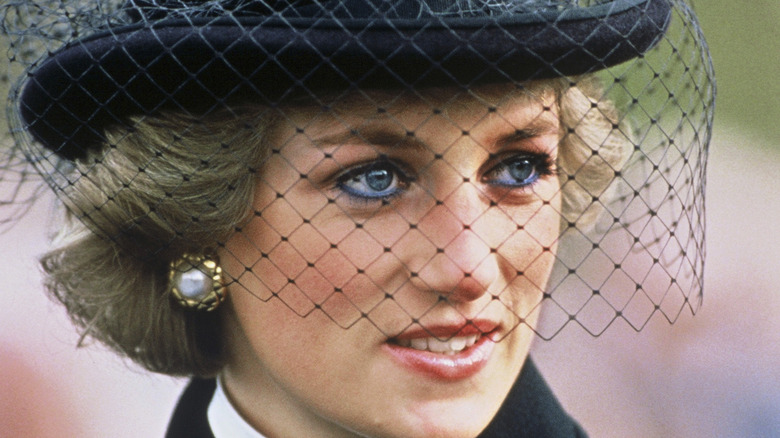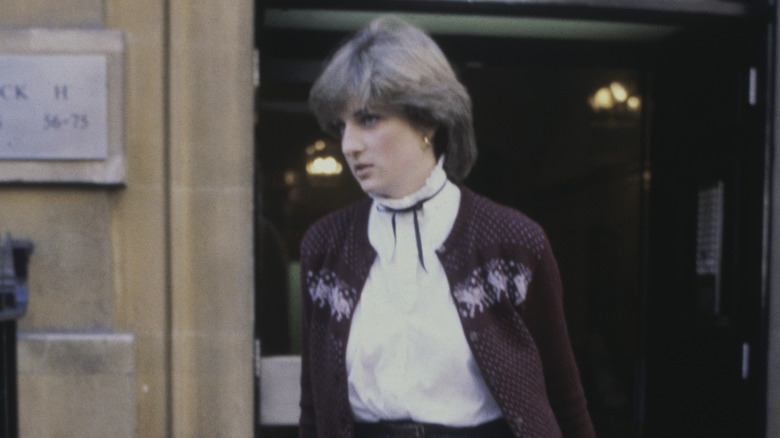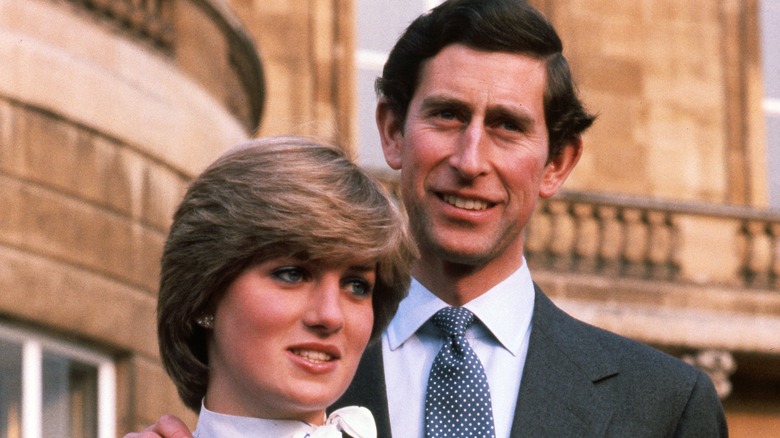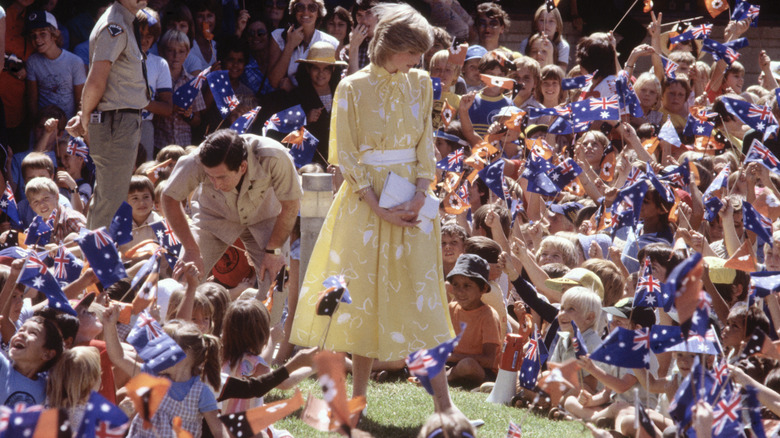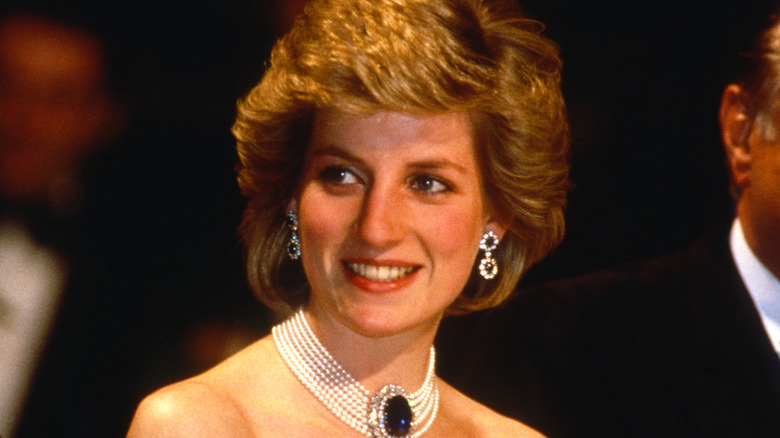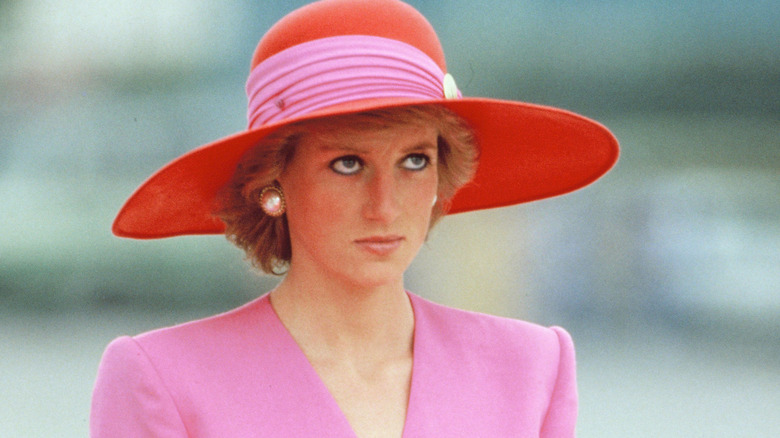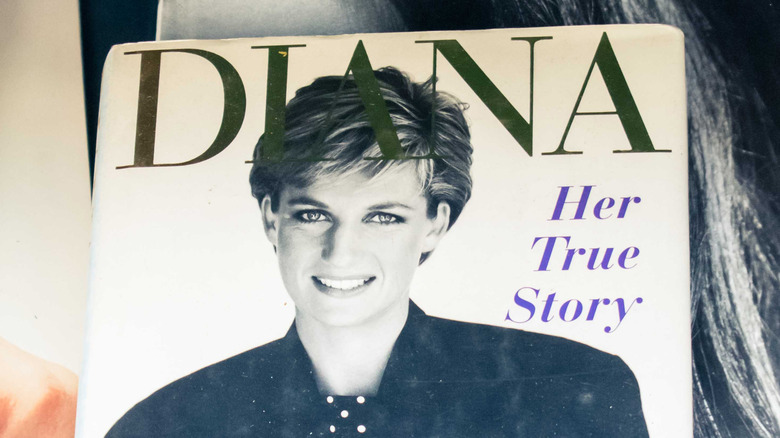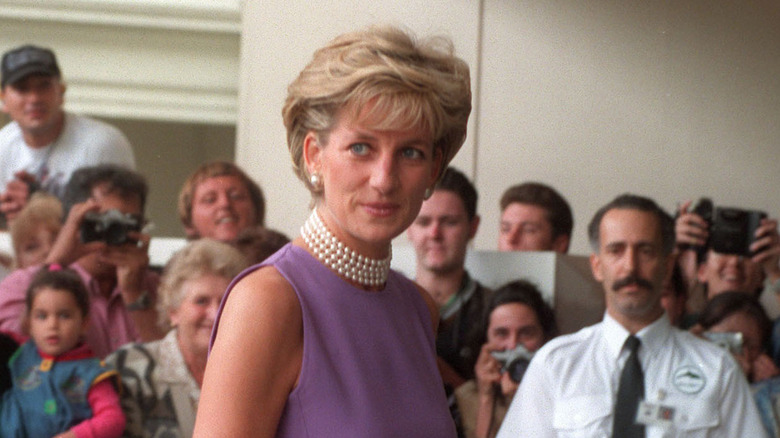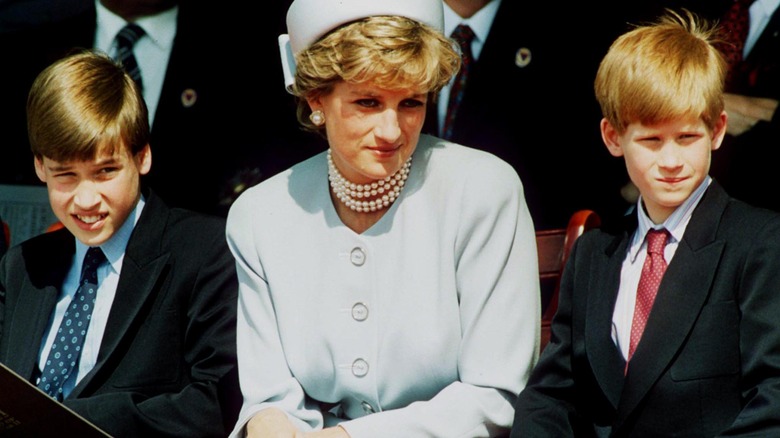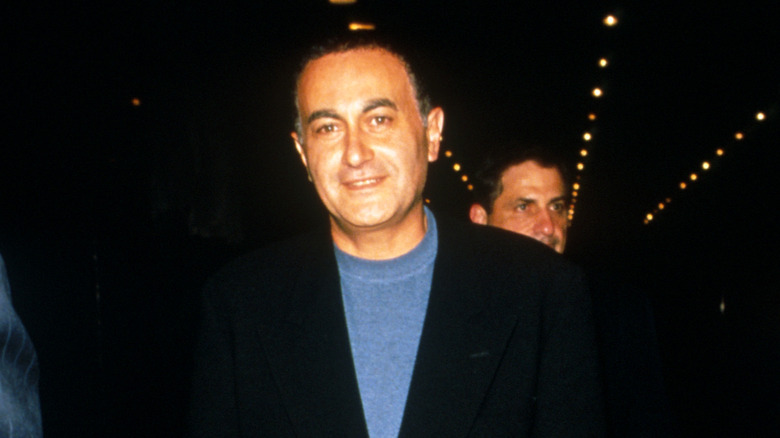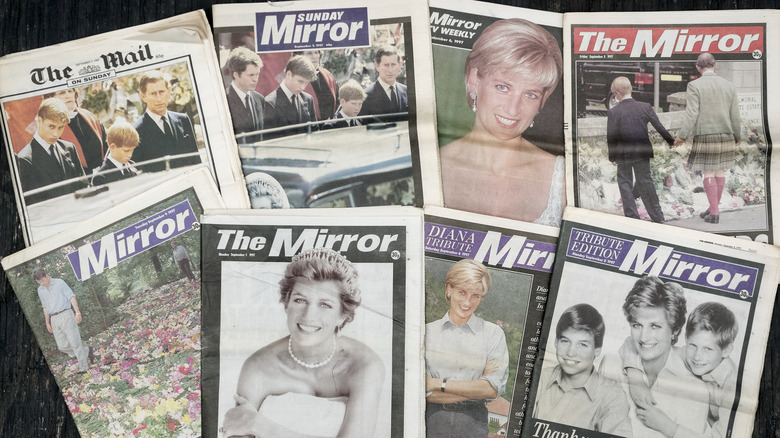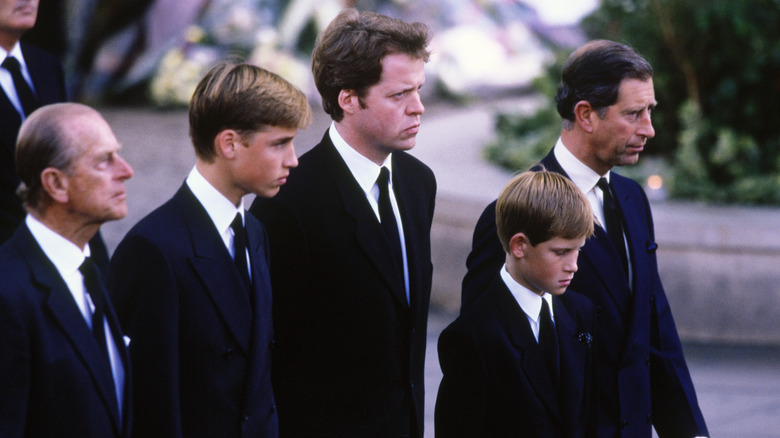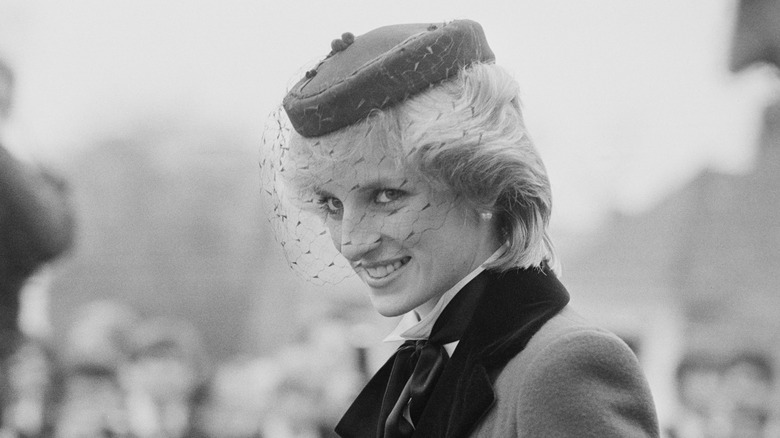Princess Diana's Relationship With The Press Was Rocky From The Start
We may receive a commission on purchases made from links.
She was the most photographed woman in the world. And with a public so eager to consume any paper with her face plastered on the cover, it's no wonder Diana Spencer had a tumultuous relationship with the press.
When she first came on the royal scene in the early 1980s, Diana was the timid, young teenager who had seemingly captured the heart of the most eligible bachelor, then-Prince Charles, the heir to the British throne. Instantly recognized for her doe-eyed expression and wallflower-type personality, the Princess of Wales quickly garnered the nickname "Shy Di" from the paparazzi, and despite making it clear that she wanted to hide from their intrusive advances, a young Diana was all but hunted down by the cameras.
In the decades that have followed since her untimely death — and especially with her son, Prince Harry, being incredibly vocal about the abuses taken on behalf of the paparazzi — Diana's relationship with the press has been analyzed with a fine-tooth comb. Though she was certainly the victim of invasive tactics early on in her royal life, Diana soon discovered the power that she had as the most recognizable woman in the world and started using the press to her advantage. It was a symbiotic relationship that left incredible impact on those involved, Diana included. Here's what really happened between the late Princess of Wales and the members of the press, and everything that had to change following her tragic death in 1997.
The princess's first interactions with the paparazzi had negative impacts
In the wake of Diana Spencer's death, her early interactions with the members of the press, the craning cameras of the paparazzi, and the public's desire to eat up anything that she did became increasingly scrutinized. One of her earliest interactions with the cameras was particularly focused on, as it threw the young princess into the lion's den with little repercussions.
Detailed in-depth in the 2017 documentary "Diana and the Paparazzi," one of Diana's earliest photo ops came during her first official engagement — before she even married then-Prince Charles. Smiling for the cameras with a particularly bright background behind her, Diana's dress she was wearing for the occasion gave the impression that it was see-through. Instantly, she was horrified that such an occurrence had happened, and it quickly set the tone for Diana's relationship with the press.
The documentary additionally included rare footage of Charles speaking about Diana at that very early stage in their relationship, talking about his fiancée and the first time he met her. She was just 16 at the time, whereas he was in his late 20s. The dynamic between the couple, their significant age gap, and the ways in which Diana was seemingly swept up in the power of the paparazzi instantly gave the press the upper hand.
Diana's very first interview left her 'traumatized'
Every fan of "The Crown" knows that when a young (and fictitious) Diana Spencer and then-Prince Charles were interviewed right after announcing their engagement, the then-heir to the throne gave an off-the-cuff remark that was truly horrifying. Sadly, such a scene was not simply written for the Netflix hit about the royal family: It actually happened, and the interaction between the couple and the press left an impressionable Diana absolutely devastated.
After making their engagement news public in 1981, Diana and Charles posed for now-famous photographs and chatted with members of the press about their relationship. They were asked how they met, what their courtship was like, what plans they had for the wedding — all of the usual questions — before a reporter asked if they were in love, a seemingly odd inquiry given that they had just announced their engagement. Diana later reflected on what happened during her biography, "Diana: In Her Own Words."
"This ridiculous [reporter] said, 'Are you in love?' I thought, what a thick question. So I said, 'Yes, of course, we are,' and Charles turned round and said, 'Whatever love means,'" Diana recalled of her soon-to-be husband's off-the-cuff remark. "And that threw me completely. I thought, what a strange answer. It traumatized me." Such an interaction arguably set the stage for Charles and Diana's dueling press tactics throughout their marriage and separation.
It became clear that her husband was not going to help her navigate her new fame
Many people seem to forget that Diana Spencer was barely out of her teens when she became the most watched woman in the world. Given her early interactions with the press, it was easy to see that she was incredibly unprepared for the role in which she had stepped into.
Sadly, then-Prince Charles also made it clear that he would not be of any help to her, with Roxanne Roberts of The Washington Post asserting, "Charles — in love with Camilla Parker Bowles and ill-equipped to deal with a naive, emotionally fragile young woman — was unable or unwilling to help her." Not only that, but it became evident during the couple's early years of marriage that Charles was becoming increasingly jealous of Diana and the press attention she was receiving. In his eyes, he was the heir, not her.
Things came to a head in 1983 when the couple toured Australia. The crowd ate up everything that Diana said, did, wore — they simply could not get enough of her. In her infamous BBC interview in 1995, Diana reflected on the press attention she received during the tour, and how it cast a wedge between her and her husband. "We'd be going round Australia, for instance, and all you could hear was, 'Oh, she's on the other side,'" Diana recalled. "With the media attention came a lot of jealousy."
Diana started using the press to her advantage when she realized her influence
Throughout the 1980s and as she started stepping into her own power, Diana Spencer soon realized that if she was not going to get support from her husband, she would turn to the public — after all, they simply adored her.
The Smithsonian released the 2017 documentary "Diana and the Paparazzi" and took an even closer look at that particular dynamic, asserting that given her power and influence, Diana could manipulate the press just as much as they manipulated her. Sir David English, the former chairman of the Associated Newspapers and a friend and confidant of the late princess, further expanded on the changing dynamic between Diana and the press that took hold in the 1980s.
"It is an undisputed fact that the princess connived with the media and exploited it for her own interests, just as much as we exploited her for ours," he wrote, as detailed by royal correspondent Sally Bedell Smith for Vanity Fair in 1998. As this dynamic between the princess and the press continued to evolve — one that used to take advantage of "Shy Di," but later did her bidding on her terms — Smith commented that Diana truly stepped into her power when she started to use the press to speak candidly about her marriage, an aspect of her public life that would start to unfold in the early 1990s.
The princess was particularly obsessed with how she was portrayed in the papers
Many celebrities these days will admit to never Google searching themselves. Some stars simply don't want to see how they're being portrayed online or what people are saying about them. Diana, however, did not fall into this mindset.
Arguably the first person to truly go viral in a worldwide sense — even before social media took hold of the press and the ways in which we communicate — Diana was reportedly obsessed with how she was being portrayed in the papers and what the members of the press were saying about her. According to one of her close friends, the Princess of Wales even had a morning routine that completely revolved around the headlines.
While sitting over breakfast in her Kensington Palace residence, Diana would read The Sun, the Daily Mirror, Express, and the Daily Mail (the order varied) like clockwork. After getting past the front page and the dominating headlines, she would then look at the inner workings of the papers and make sure that she was being portrayed in a good light. In fact, her friend admitted that during a party, Diana got lost during a conversation as she was focused on a pile of newspapers. When asked if she wanted one, Diana agreed, gave the papers a flip through, and carried on with the conversation. "Not a bad day for me," she was said to have commented during the interaction.
By 1992, Diana started working with a member of the press on a tell-all book
To say that Diana Spencer and then-Prince Charles's marriage was a complete train wreck is perhaps the understatement of the century. Their union was fraught with tension, a lack of understanding, very little support from the institution, and — of course — infidelity, notably Charles's ongoing affair with Camilla Parker Bowles.
By 1992, Diana was ready to speak her truth and did so rather secretly. She began working with journalist Andrew Morton, recording her stories and sending them to him via mutual friend James Colthurst. The result was Morton's bombshell book, "Diana: Her True Story," and her involvement with the project was only revealed in full after her passing. The biography shed new light on the status of Diana and Charles's marriage at the time, casting Diana's experiences at the hands of the firm and the press into the spotlight like never before. Later reflecting on her involvement, Morton told TIME that he is still amazed that Diana trusted him with her most private experiences.
"However many books I write for the rest of my days, I'll always be remembered for one book, and that's the Diana book," he said, before noting that their joint venture would be included in Netflix's "The Crown." "And that's because of this extraordinary story, which you will see on 'The Crown,' of a future queen involved in a secret conspiracy with somebody she hardly knew — that was me."
Amid her separation and divorce, Diana was on a first-name basis with newspaper editors
Though the status of her involvement with Andrew Morton's book was more rumor than truth at the time of its release, it became clear that Diana Spencer knew what she was doing when it came to the press. She was no longer the young princess, but rather the sophisticated royal who knew how to play the game. After all, the British press was (and still is) notorious for being particularly brutal, yet Diana knew just how important her symbiotic relationship with the media was.
By 1992, Diana and then-Prince Charles had formally separated, and the Princess of Wales was on her own in a way that she hadn't been before — her relationship with the press became closer than ever, and she continued to foster important relationships. In fact, Diana's piqued interest in how she was portrayed in the press extended far past the pages. She was said to have had close relationships with the editors of Britain's major tabloids, and met with them at her residence in Kensington Palace on occasion. In fact, one of their get-togethers happened just two months before she died.
Speaking to PBS, one of the tabloid editors said of their meet-ups, "I would be happy to go on the record about my relationship with the princess at some point in the future, but now is not the time or place. It is bound to be misinterpreted."
Diana confided in a member of the press that she wanted to drastically change her life shortly before her death
The extent of Diana Spencer's relationship with the press certainly extended past professional friendships. As it turns out, she had a number of confidants within the press community that she sought both advice and comfort from. One of them, who shared a particularly close relationship with her, was the Daily Mail's Richard Kay. Diana was said to regularly turn to Kay throughout the 1990s, and though she shared a great deal, the reporter admitted that he never really could predict what she was going to say or do next. Astonishingly, Diana called him just hours before the tragic car accident that took her life in August 1997, telling him that she wanted to start over completely.
"She had decided to radically change her life. She was going to complete her obligations ... and then, around November, would completely withdraw from her formal public life," Kay admitted of their final conversation, taking place moments before she stepped into the Mercedes vehicle that crashed in the Pont de l'Alma tunnel in Paris. "It was a dream sequence I'd heard from her before, but this time I knew she meant it. My feeling was at that time she meant it, but she could have changed the next week."
The coverage of Diana in the weeks leading up to her death was incredibly negative
Though the details of her marriage maintained during it were all vetted in the headlines, Diana Spencer largely enjoyed favorable coverage from the press. She was, after all, the "people's princess," and spent the majority of her time bringing much-needed attention to vital humanitarian work. However, in the weeks before her death, Diana's coverage in the main headlines was increasingly negative, a stark contrast from the glowing reviews she was used to.
At the time, Diana was bringing attention to landmines and the importance of ridding them worldwide — work that her son, Prince Harry, has continued to this day. However, her efforts were said to have irritated British lawmakers for both economic and political reasons, and her ongoing relationship with Dodi Al-Fayed was the icing on the bad press cake. Seemingly attempting to control the narrative, Diana dropped a hint to members of the paparazzi that she and Dodi would be on vacation together — in case they wanted to snap the pic — but the coverage was not at all what she expected. In fact, her relationship with Dodi was absolutely skewered, much to her surprise.
"They were really lurid," Sally Bedell Smith told USA Today of the photographs. "There had been a crescendo of salacious headlines in the weeks before she died, three weeks of the wildest tabloid coverage ever seen, tearing Dodi apart, turning on Diana. It was highly unusual."
The members of the press quickly reacted to the news of Diana's death
Diana Spencer's death in 1997 is one of those moments that many can recall where they were when they found out about it. For the journalists and members of the press that had come to know and work with Diana over the years, her fatal car accident scorched their memories of her. Though they had to quickly jump on the story to deliver the news to the world, they were also mourning her death personally, as they had all enjoyed a symbiotic relationship that, while complex, benefitted both parties.
Jocelyn Noveck, the Associated Press news editor in Paris at the time, recalled the exact moment when the news broke. "All of a sudden there was this cacophony of mobile phones going off," she said (via AP News). "The first one that went off was a British reporter's ... and he just got up and started running. And the rest of us called out, 'What happened?' And he just said, 'The Princess of Wales! Crash!' And then kept running."
Chris Burns, a former AP reporter, later recalled the moment he was standing outside of the Paris hospital Diana was taken to, waiting for any news about her condition. "Finally, after this long description, [the doctor] said, 'We were unable to revive her.' ... I think it was 4 a.m. And there was this moment of silence ... Princesses don't die this way anyway, do they?
Diana's brother specifically asked the tabloids not to attend Diana's funeral
Throughout her life and amid her death, Diana Spencer's relationship with the press was on full display. Though the dynamic was mutually beneficial — and mutually destructive — Diana's brother, Earl Spencer, specifically asked that the editors of the British newspaper not attend her funeral, given that the ongoing coverage of her life and death was incredibly sad, complex, and unforgiving.
A spokeswoman for Diana's brother later said, "[Earl Spencer] personally asked the tabloid editors not to come, because he and his sisters, particularly Diana, would not have wished them to be there. They have kindly agreed to the request, although broadsheet and regional papers are welcome."
In hindsight, however, it was probably a safe bet for the newspaper editors not to attend. During his eulogy for his sister, Earl Spencer absolutely skewered the members of the press and essentially blamed them for her death, as she was being chased by paparazzi at the time of her fatal car accident. "[She was] the most hunted person of the modern age," her brother said of Diana during her funeral, hinting at the intense press coverage that she had lived with for almost two decades (via BBC). "She would want us today to pledge ourselves to protecting her beloved boys William and Harry from a similar fate. We will not allow them to suffer the anguish that used regularly to drive you to tearful despair."
Diana's death completely changed the ways in which the British media operated
After Diana Spencer's death, the British media, known for their unruly tactics and emboldened approach to sensationalized reporting, had to tread very carefully. A Gallup poll taken shortly after her passing showed that about 43% of the British public thought that members of the paparazzi were responsible for her death, rating their involvement at the "Extreme" level presented as an option. Not only was the public not on their side, but the press had to contend with their biggest sales driver, Diana, no longer being a constant in their lives and coverage. Undeniably, the press had to evolve overnight.
The public's perspective on the press did not change overnight, however. Both the Mirror and The Sun reported their worst sales figures following Diana's death, and many reporters abstained from sharing their occupation with others given the public's overwhelming disapproval.
"For months after Diana's death, I wouldn't mention that I worked for a magazine that published paparazzi pictures because we were the lowest of the low," Mark Frith, who worked for a number of publications, told TIME of Diana's passing and the impact it had on the press. "That feeling certainly lasted for the rest of that year."
